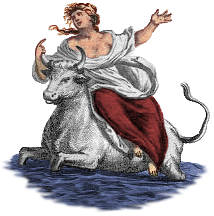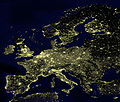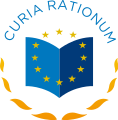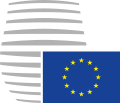
Back بوابة:الاتحاد الأوروبي Arabic Portal:Avropa İttifaqı Azerbaijani প্রবেশদ্বার:ইউরোপীয় ইউনিয়ন Bengali/Bangla Portal:Unió Europea Catalan Portál:Evropská unie Czech Portal:Den Europæiske Union Danish Portal:Europäische Union German Πύλη:Ευρωπαϊκή Ένωση Greek Portal:Unión Europea Spanish Teemasivu:Euroopan unioni Finnish
Introduction
The European Union (EU) is a supranational political and economic union of 27 member states that are located primarily in Europe. The Union has a total area of 4,233,255 km2 (1,634,469 sq mi) and an estimated total population of over 448 million. The EU has often been described as a sui generis political entity (without precedent or comparison) combining the characteristics of both a federation and a confederation. Containing 5.8% of the world population in 2020, EU member states generated a nominal gross domestic product (GDP) of around US$16.6 trillion in 2022, constituting approximately one sixth of global nominal GDP. Additionally, all EU states except Bulgaria have a very high Human Development Index according to the United Nations Development Programme. Its cornerstone, the Customs Union, paved the way to establishing an internal single market based on standardised legal framework and legislation that applies in all member states in those matters, and only those matters, where the states have agreed to act as one. EU policies aim to ensure the free movement of people, goods, services and capital within the internal market; enact legislation in justice and home affairs; and maintain common policies on trade, agriculture, fisheries and regional development. Passport controls have been abolished for travel within the Schengen Area. The eurozone is a group composed of the 20 EU member states that have fully implemented the economic and monetary union and use the euro currency. Through the Common Foreign and Security Policy, the union has developed a role in external relations and defence. It maintains permanent diplomatic missions throughout the world and represents itself at the United Nations, the World Trade Organization, the G7 and the G20. Due to its global influence, the European Union has been described by some scholars as an emerging superpower. In 2012, the EU was awarded the Nobel Peace Prize. The United Kingdom became the only member state to leave the EU, in 2020; ten countries are aspiring or negotiating to join it. (Full article...) Selected article€2 commemorative coins are special euro coins minted and issued by member states of the Eurozone since 2004 as legal tender. The coins typically commemorate the anniversaries of historical events or draw attention to current events of special importance. Eighteen variations of €2 commemorative coins have been minted. €2 commemorative coins have become collectibles. The basis for the commemorative coins derived from a decision of the European Council, which repealed the prohibition of changing the national obverse sides of euro coins from 1 January 2004 onwards. The face value of the coins, typically is less than their intrinsic value of between €3 and €12. The exceptions are San Marino and the Vatican City, where coins from the former are regularly sold for between €30 and €40, while coins from the latter are very rarely obtained for less than €100. Issued designs are made public in the Official Journal of the European Union. Selected pictureMap credit: Robert Wilkinson An 18th century map of the Iberian Peninsula illustrating various topographic features of the land. The Iberian Peninsula, or Iberia, is located in the extreme southwest of Europe, and includes modern day Spain, Portugal, Gibraltar and Andorra.
Did you know?... that the presidency of the EU Council rotates every half year? ... that the EU parliamentary election is the world's biggest transnational election? ... that the European Union was awarded the Nobel Peace Prize in 2012? Selected cityStockholm is the capital of Sweden, and consequently the site of its Government and Parliament as well as the residence of the Swedish head of state, King Carl XVI Gustaf. Stockholm has been Sweden's political and economic center since the 13th century. Today it is the largest municipality of Sweden, with a population of 776,000, while the populations of the Stockholm urban area and Metropolitan Stockholm are roughly 1.2 and 1.9 million, respectively. With its location on the east coast of Sweden at the mouth of Lake Mälaren, by the Stockholm archipelago, it is widely renowned for its beauty. The city is said to have been founded by Birger Jarl in order to protect Sweden from a sea invasion by foreign navies, and to stop the pillage of towns such as Sigtuna on Lake Mälaren. It is also said that the name derives from the spot where a log (stock) pushed into the waters, and following its currents, drifted upon an islet (holm). This location would thus constitute the best location for a harbour for returning ships. General imagesThe following are images from various European Union-related articles on Wikipedia.
TopicsFeatured contentFeatured articles
Featured lists
Featured contentGood articles
CategoriesRelated portalsAssociated WikimediaThe following Wikimedia Foundation sister projects provide more on this subject:
Discover Wikipedia using portals |
© MMXXIII Rich X Search. We shall prevail. All rights reserved. Rich X Search































































